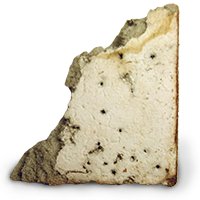Bulk/ swab/ wipe, semiquantitative fungal culture [FC-S]
Published: July 8th, 2009
Revised: March 21st, 2023
Bulk samples
 In the laboratory, a semiquantitative fungal culture of a bulk sample is generally carried out by aseptically taking tiny shavings from the specimen and sprinkling them over the surface of a Petri dish filled with growth medium. Alternatively, a swab may be used in the laboratory to recover any loose debris from the surface of a bulk sample, and then rolled on the surface of a growth medium. A third method for semiquantitative testing of bulk samples involves washing all or a portion of the surface of the material with a sterile buffer solution, and transferring an aliquot of the resulting suspension to a Petri dish. Which particular procedure is indicated is a subjective decision and it depends to a great extent on the size, composition and overall appearance of the sample. The advantage to starting with a bulk sample is that it permits the laboratory to determine which approach is most suitable, possibly including several parallel approaches to achieve the most accurate result.
In the laboratory, a semiquantitative fungal culture of a bulk sample is generally carried out by aseptically taking tiny shavings from the specimen and sprinkling them over the surface of a Petri dish filled with growth medium. Alternatively, a swab may be used in the laboratory to recover any loose debris from the surface of a bulk sample, and then rolled on the surface of a growth medium. A third method for semiquantitative testing of bulk samples involves washing all or a portion of the surface of the material with a sterile buffer solution, and transferring an aliquot of the resulting suspension to a Petri dish. Which particular procedure is indicated is a subjective decision and it depends to a great extent on the size, composition and overall appearance of the sample. The advantage to starting with a bulk sample is that it permits the laboratory to determine which approach is most suitable, possibly including several parallel approaches to achieve the most accurate result.
Swab samples
 Despite their ease of handling, swab samples are generally poorly suited as field methods for sample collection. Swabs with a woven Dacron tip are ideal, and for the purposes of fungal sampling, these should lack a gel or liquid medium in their transport tube (in other words, they are “dry” swabs). This is important because exposure of collected spores and other cells to any moisture may result in cell germination, and because the surrounding medium is unsuitable for growth, the nascent fungus may die. By contrast, moist transport media are a necessity for bacterial sampling, since many types of bacteria die quickly in the absence of moisture.
Despite their ease of handling, swab samples are generally poorly suited as field methods for sample collection. Swabs with a woven Dacron tip are ideal, and for the purposes of fungal sampling, these should lack a gel or liquid medium in their transport tube (in other words, they are “dry” swabs). This is important because exposure of collected spores and other cells to any moisture may result in cell germination, and because the surrounding medium is unsuitable for growth, the nascent fungus may die. By contrast, moist transport media are a necessity for bacterial sampling, since many types of bacteria die quickly in the absence of moisture.
Field sample collection
- Don a pair of nitrile gloves and remove the swab from the blister pack or tube, taking care to handle it only by the distal end or lid.
- The area to be tested should be an area roughly between 1-100 cm². Gently rub the swab tip in a back and forth motion on the surface being tested, rotating the swab slightly as the sampling proceeds to cover the entire sampling area. Note that the precise area sampled is only important if relative comparisons are likely to be needed between swab samples.
- Insert the swab into the transport tube and secure the lid. Be sure to write the sample collection data on the attached label, including the job number, sample number, sampling date, surface type sampled and approximate area swabbed.
- Multiple swabs may be placed in a clean, new reclosable zippered plastic bag, and stored in a dark, cool place until receipt by the laboratory. There is no need to ship swab samples with an ice pack or other means of temperature control. We have found that simply packing the swabs in a padded envelope provides sufficient temperature protection in most cases.
Wipe samples
Certain sampling settings, such as irregular surfaces, are poorly suited to either bulk or swab sampling. Wipe samples may be more suited to these situations, since much more force can be applied to the sampling surface, and the flexibility of the wipe allows it to better conform to the contours of the sampling surface. We use wipes for biological sampling. Wipe samples may be collected in a manner similar to the above swab sampling procedure. Once the wipe has been sampled, it should replaced in the labeled transport pouch.
Laboratory code: FC-S
Service options

Results reporting
Results of semiquantitative bulk samples, swabs and wipe samples are given as 1+, 2+, 3+, etc., where the numeral preceding the plus sign indicates the order of magnitude of each taxon observed in the sample.



